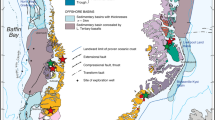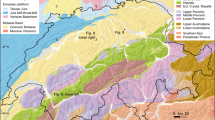Abstract
The nuclear industry was used as a case history to examine the influences between science and industry. The nuclear resources aspect of the industry was chosen for study. A correlation is found among indicators of geoscience research, exploration for uranium ores, production of uranium, and the general state of the industry. Some of the science-industry interfaces were identified as fruitful areas for further study, and a historical analysis of exploration technology shows that a scientific development engendered by the requirements of an early phase of the industry was key to later expansion in exploration and resources discovery.
Similar content being viewed by others
Notes and references
See for example National Science Board, (1983),Science indicators, 1982, Washington, D. C. NSB/NSF; this same series for other years; and the reference in Note 2..
B. R. MARTIN, J. IRVINE, Assessing basic research, some partial indicators of scientific progress in radio astronomy,Research Policy, 12 (1983) 61.
D. DE SOLLA PRICE,Little Science, Big Science. Columbia University Press, 1963, 118 p. (Reprinted in Columbia Paperback Edition, 1965).
H. W. MENARD,Science: Growth and Change, Harvard University Press, 1971, Cambridge, Mass., p. 215. D. H. HALL, History of the Earth Sciences during the Scientific and Industrial Revolutions, Elsevier Scientific Publishing Co., 1976, p. 297.
Recent references to these articles are: Energy Research and Development Administration (ERDA), 1975. Statistical Data of the Uranium Industry, USA; Energy Information Administration (EIA), 1984. Uranium Industry Annual, Washington, D. C., 144; R. T. WHILLANS. Uranium.Canadian Mining Journal, February issue (1986) 83–85. Earlier references can be followed back in these series. (For theCanadian Mining Journal, see the February issue each year).
See the EIA reference in Note 5: Energy Research and Development Administration (ERDA), 1975.
The OECD Nuclear Energy Agency and the International Atomic Energy Agency. Uranium resources, production and demand, 1975, 22–27; 1977, 16–25; 1978, p. 8, p. 14; 1979, 22–23, 46–49; 1983, p. 48, p. 50.
Energy, Mines and Resources (EMR), 1984. Uranium exploration drilling and surface development drilling activity and uranium exploration expenditure in Canada, 1976–1984. Ottawa, p. 2.
M. B. LIEBERMAN, United States uranium resources—an analysis of historical data,Science, 192 (1976) 431.
See the following: J. W. GRIFFITH, 1967. The uranium industry—its history, technology and prospects. Canada Department of Energy, Mines and Resources, Minerals Resources Division, Mineral Report 12. Queen's Printers, Ottawa, 335; the reference in Note 7 The OECD Nuclear Energy Agency and the International Atomic Energy Agency. Uranium resources, production and demand, 1975, 22–27; 1977, 16–25; 1978, p. 8, p. 14; 1979, 22–23, 46–49; 1983, p. 48, p. 50; and the reference in Note 8 Energy, Mines and Resources (EMR), 1984. Uranium exploration drilling and surface development drilling activity and uranium exploration expenditure in Canada, 1976–1984. Ottawa, p. 2.
See the references toPrice, Menard andHall, Note 3. D. DE SOLLA PRICE,Little Science, Big Science. Columbia University Press, 1963, 118 p. (Reprinted in Columbia Paperback Edition, 1965). Note 4. H. W. MENARD,Science: Growth and Change, Harvard University Press, 1971, Cambridge, Mass., p. 215. D. H. HALL, History of the Earth Sciences during the Scientific and Industrial Revolutions, Elsevier Scientific Publishing Co., 1976, p. 297.
The printed publication has appeared as follows at various times during its lifetime: 1785–1928: Geologic literature on North America. Geological Society of America; 1929–1970: Bibliography of North American Geology. Geological Society of America; 1933–1968: Bibliography and Index of Geology Exclusive of North America. Geological Society of America and American Geological Institute; 1969—Present: Bibliography and Index of Geology. Geological Society of America and American Geological Institute. GEOREF is a comprehensive computer database in the geosciences, and is produced by the American Geological Institute. It corresponds to the above printed publications.
See p. 23 of the reference toHall in Note 4 H. W. MENARD,Science: Growth and Change, Harvard University Press, 1971, Cambridge, Mass., p. 215. D. H. HALL, History of the Earth Sciences during the Scientific and Industrial Revolutions, Elsevier Scientific Publishing Co., 1976, p. 297.
C. M. BUCKLEY, G. S. MACKERRON, A. J. SURREY. The international uranium market,Energy Policy, June (1980) 84.
R. M. WILLIAMS, Uranium,Canadian Mining Journal, Feb. (1967) 169.
C. A. HEILAND,Geophysical Exploration, Prentice-Hall Inc., New York, 1940, p. 833.
ANON, Special types of Geiger counters (editorial),Canadian Mining Journal, December (1949) 70.
ANON, New uses for Geiger counters (editorial),Canadian Mining Journal, June (1949) 88.
E. A. GODBY et al., Aerial prospecting for radioactive materials, National Research Council of Canada, Report No. MR-17, CRR-495 (1952) p. 1–3.
F. W. STEAD. Airborne radioactivity surveying speeds up uranium prospecting,Engineering and Mining Jorunal, September (1950) 75.
G. COWPER, Aerial prospecting with scintillation counters,Nucleonics, 12 (1954) 29.
H. J. DIGIOVANNI, R. T. GRAVESON, A. H. YOLI, Scintillation unit for drill-hole logging,Nucleonics, 11 (1953) 34; F. J. DAVIS, J. A. HARTER, P. W. REINHARDT, C. F. HARRIS, Scintillation detector for carborne and airborne use,Nucleonics, 12 (1954) 46.
R. W. PRINGLE, K. I. ROULSTON, G. M. BROWNELL, 1954. Apparatus for scintillation spectrometry. United States Patent No. 2,686,266.
H. T. F. LUNDBERG, R. W. PRINGLE, G. M. BROWNELL, 1959. Aerial geophysical exploration with a scintillation spectrometer. United States Patent No. 2,897,368.
See p. 6 in the reference toPrice in Note 3 D. DE SOLLA PRICE,Little Science, Big Science. Columbia University Press, 1963, 118 p. (Reprinted in Columbia Paperback Edition, 1965).
Author information
Authors and Affiliations
Rights and permissions
About this article
Cite this article
Hall, D.H. The interface between geoscience and industry: A case study of the interaction between research and the discovery and mining of ores for nuclear fuels. Scientometrics 11, 199–216 (1987). https://doi.org/10.1007/BF02016592
Received:
Issue Date:
DOI: https://doi.org/10.1007/BF02016592




